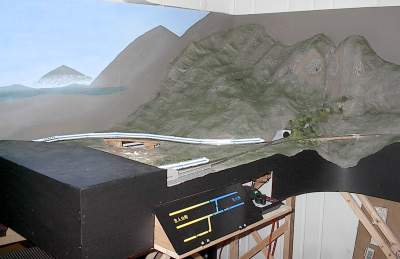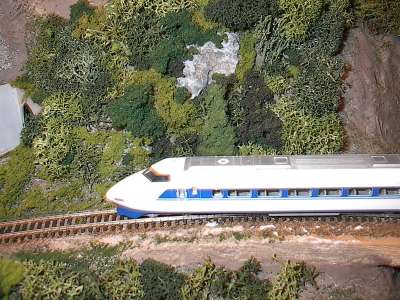Shujinkousen Scenery
Photos

- Control panel painted and installed.
- Obviously, controls aren't mounted yet!.
- Panel is mounted on hinges for easy access to wiring inside.

- Foothills of large mountain near Shujinkoumachi.
- Cardboard webbing provides basic shape. This doesn't need to be very strong; the plaster shell will be self supporting once it sets.
- The circling track will end up completely enclosed by the mountain. The shell is built down to the track to provide a shelf to protect trains from accidental falls.

- The same foothills, now covered with a plaster shell.
- The shell is made of plaster-impregnated gauze. This is a great material to work with! It's very lightweight, it sets fast, and it doesn't make anywhere near as much mess as paper towels dipped in plaster or hydrocal.

- A steep valley in the mountains near Shujinkoumachi.
- The northbound track (the farther one) will be in a tunnel under this mountain.
- The southbound track crosses the valley on a low bridge.

- The same steep valley, now with its plaster shell.
- To the left, you can see where the tunnel entrance will be for trains leaving Shujinkoumachi (just past the crossover).
- The tunnel exit is barely hidden behind a low ridge from this viewing angle.
- You can see the cardboard "ridgeline" for more mountains to the right.
- The left "peak" won't actually be a peak; it's part of the slope of the mountain that will be built over the circling track.

- The tunnel portal under Shujiyama, for northbound trains from Shujinkoumachi.
- It is scratch-built of ABS plastic.
- If you look closely, you can see ballast on the track near the portal. I painted the ties and ballasted at tunnel portals because that will be impossible to do later.

- Shujiyama's cardboard support structure is clearly visible.
- The backdrop is up, too!
- The thing that looks a little bit like a mouse, halfway up the completed portion of the shell, is actually a small triceratops that has taken up permanent residency on the layout.

- Here's how the backdrop is constructed.
- Simple 1x2 risers were attached to joists. Where necessary, new joists were added to bolster support.
- The backdrop itself is made of inexpensive foam-core, which is very lightweight and rigid, and easily cut with an X-Acto knife (but not, as I discovered, with a utility knife).
- The foam-core was simply glued to the risers with wood glue, then clamped in place until the glue dried.
- Lacking diagonal braces, the backdrop is not as strong as it could be. But it is bolstered by the plaster scenery shell, and it does not need to bear a lot of weight.
- Holes are easily cut through the back to provide access to track that is underneath the scenery.

- The fascia is half complete.
- The flat area above the tunnel portal is where Mikumaji (the temple) will be.
- This is a pretty good overview of the northern end of the mountain pass area.

- The rest of the fascia.
- The raised section over the instrument panel will be cut back some; its final shape depends somewhat on how I structure the urban area there.
- You can still see the resident triceratops on the mountain.

- A northbound 100-series emerges from a tunnel under Shujiyama.
- You can pretend it's winter, and that's why there is no vegetation and everything is white.

- The northbound 100-series passes under the future site of Mikumaji as it heads back under the mountains.

- The northbound 100-series passes a southbound 100-series just north of Mokidate.
- The flat area in the foreground is the site of Mokidate.
- You can faintly see a horizon line I've sketched onto the backdrop as a guide for future painting.

- The 100-series loops through Shujinkoumachi.
- The black flat area is to be covered with city buildings.
- The base brown coloring is latex paint.
- The green texture is several mixed shades of ground foam, secured with acrylic matte medium.

- This is the Mokidate end of the layout.

- The northbound and southbound 100-series are passing near Mokidate.

- The 100-series climbs through the mountains on the way to Mokidate.

- The 100-series enters the tunnel through Shujiyama.
- The one teensy bit of forested area is clearly visible.

- The 100-series passes by the one bit of foresting I did.
- The rock outcropping is cast plaster, painted with latex and acrylics.
- The dense vegetation is a mix of lichen and ground foam.
Back to the Shujinkousen Railroad
 Back to Azami's Hideout
Back to Azami's Hideout
This page written and maintained by Matthew Davis.
Last updated Wednesday, September 24, 2003.
To tell me my mountains are too tall, send e-mail to azami@speakeasy.net.



















![]() Back to Azami's Hideout
Back to Azami's Hideout